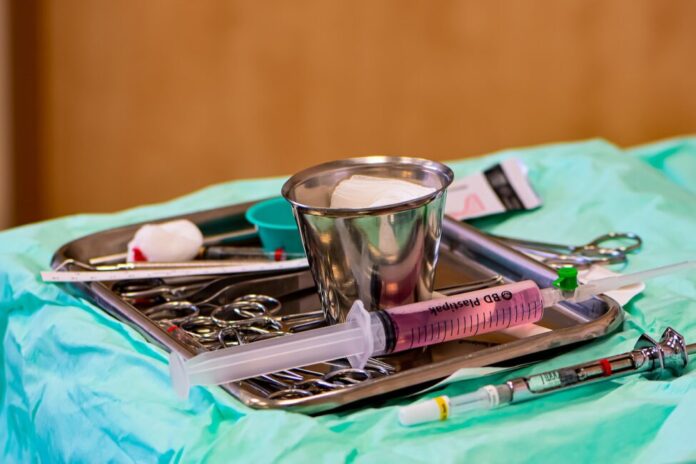Sterilization has always been an important part of the human experience. It was first used by ancient Egyptian physicians around 1500 B.C., who would burn their instruments in fires after surgery to ensure no infection remained.Â
Sterilization is now commonplace and can be achieved through various methods including radiation, heat, or chemicals that will kill living organisms such as bacteria or viruses on surfaces that are otherwise nonporous (such as metal tools). Sterilization also refers to various processes that eliminate all forms of life from tissue cultures or biological specimens stored in liquid nitrogen for long-term preservation purposes. The type of sterilization product you choose depends largely on your needs and concerns about health risks/concerns with exposure to certain chemicals.
Autoclave for sterilization equipment
An autoclave is a pressurized and steam-heated sterilizer that is commonly used in hospitals. It uses steam at temperatures of up to 250°C to kill microorganisms it touches by boiling them. There is a great offer of autoclavable medical equipment on www.leadsonics.com with containers or instruments that have been designed to withstand the high heat of an autoclave and can be reused many times after sterilizing. Please note that, although some products may claim to be autoclavable, they may not withstand the high temperature and pressure of an actual autoclave and must instead be disposable.
Autoclaves function by pressurizing steam (heated to over 100°C) to 16atm before injecting it into the sterilization chamber where it makes contact with all surfaces. The steam raises the temperature and pressure within the chamber and higher temperatures and pressures allow for a more effective sterilization process.
How sterilizers work
Sterilizers function by heating items to an ideal of 120°C for several minutes, disinfecting them from microorganisms. The heat lethally damages the cell walls of bacteria, viruses, and other microorganisms.
Sterilizers can be used to remove all microorganisms from objects such as tools, surgical instruments, or laboratory equipment. The time it takes for a sterilizer to completely disinfect an object depends on its size and how many pieces are in it (i.e., the larger the item, or the more pieces it has, the longer it will take to be sterilized).
Steam Sterilizers
Steam sterilizers are autoclaves that pressurize steam before injecting it into a machine. These machines can be used for different types of items including metal tools, plastic instruments, glassware, and other instruments.
Steam sterilizers can be used on a variety of items that will not melt at high heat and pressurize the inside of the chamber, making them effective in killing microorganisms nonetheless. This is because when heat and pressure are applied together, they make chemicals called ‘free radicals’ which attach to cells and break them down. The heat and pressure in these sterilizers kill microorganisms at a very fast rate, but it also means the instrument/object has to withstand high temperatures, around 134°C.
Top-loading vs front-loading autoclaves
Most autoclaves are top-loaders or front-loaders. Top loading autoclaves are often used in medical settings for sterilization. The instruments or tools that you want to be sterilized fill the top of the chamber and sit submerged underwater/chemical vapor which pressurizes up to 16 atm, killing off microorganisms.
Many items will have special carriers made out of metallic materials that are designed to withstand the high heat of an autoclave.
Front-loading autoclaves function similarly as top-loaders and also pressurize steam to 16 atm before it is injected into the chamber and exposes items to this high level of heat. Unlike top-loaders, front-loaders do not have a door on the opening of the machine but instead, you place your instruments or tools directly onto a moving belt that will carry them through the sterilization process.
Types of chemicals used as sterilizing agents
When choosing sterilizers, one must consider how they’ll more effectively destroy microorganisms such as bacteria and viruses: with chemicals or with high temperatures. The difficulty with chemicals is that some chemical reagents (used for different types of sterilizing) can react with the surface of materials and also be harsh on delicate instruments. If a chemical is used in a sterilizer, it must be removed from the sterilized items before they are put back into use. Chemicals that are usually used in autoclaves include formaldehyde, glutaraldehyde, hydrogen peroxide vapor, peracetic acid, and ozone.
Highly effective against spores
Sterilizers function by heating items to an ideal of 120°C for several minutes, destroying microorganisms such as bacteria, viruses, and molds. However, autoclaves cannot destroy spores: Heat resistant structures that may survive the high temperatures within the autoclave. Therefore these spores will later germinate and propagate with a release of endotoxins which can cause an infection. So to destroy such spores, some people recommend using ethylene oxide (EtO) sterilization for spore-forming microorganisms such as “Clostridium difficile” and “Bacillus anthracis”. This is effective but not suitable for standard usage due to the high toxicity and carcinogenicity.
When it comes to choosing a sterilizer, different types use either steam or chemicals to kill microorganisms. You must also consider the size of the object being sterilized and whether it can withstand high temperatures. Some items may require a special carrier due to the heat sensitivity. Additionally, you must decide if you want to use chemicals that have the potential to react with surfaces or go for a sterilizer that uses high temperatures which are effective against spores but can be harsh on instruments.
























